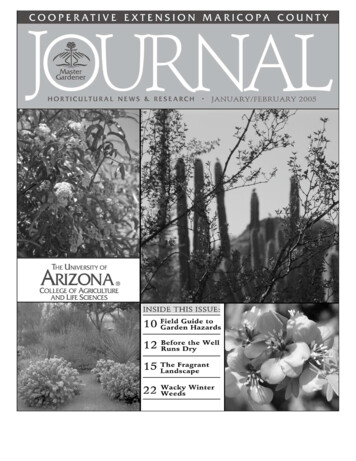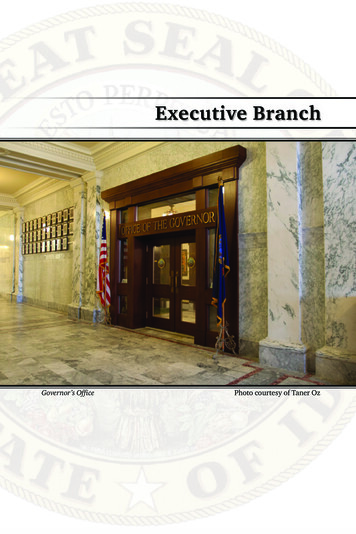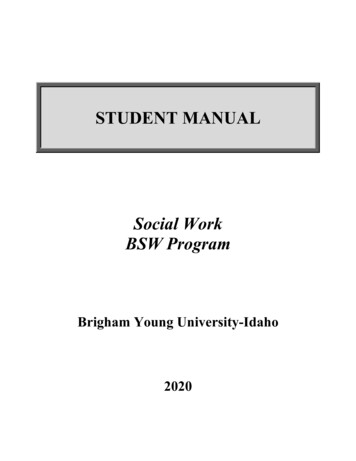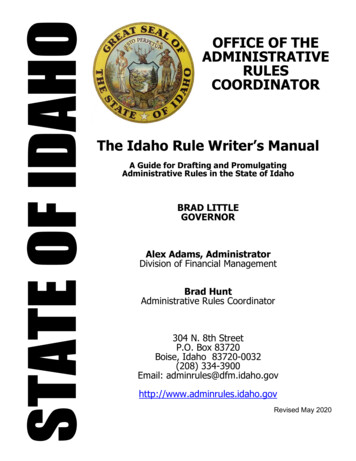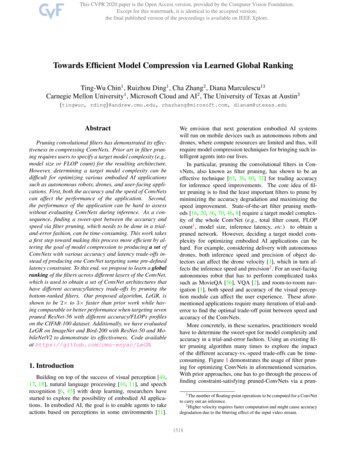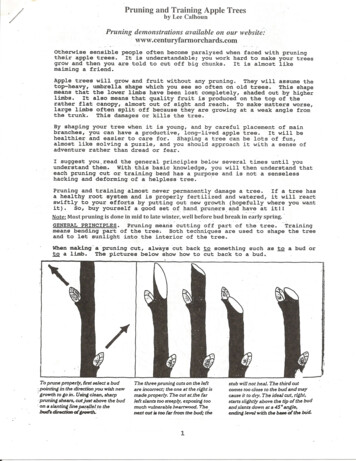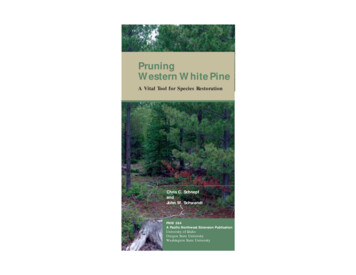
Transcription
PruningWestern White PineA Vital Tool for Species RestorationChris C. SchnepfandJohn W. SchwandtPNW 584A Pacific Northwest Extension PublicationUniversity of IdahoOregon State UniversityWashington State University
PruningWestern White PineA Vital Tool for Species RestorationChris C. Schnepf and John W. SchwandtA Pacific Northwest Extension PublicationUniversity of IdahoOregon State UniversityWashington State University
The authorsChris C. Schnepf is an Extension Forester for the University ofIdaho based in Coeur d’Alene. He provides educational programs for forest owners, loggers, and others interested inapplied forest ecology and silviculture.CONTENTSINTRODUCTION1John W. Schwandt, Ph.D., is a forest pathologist with the USDAForest Service, Region 1, in its Coeur d’Alene Field Office. Hehas been instrumental in developing pruning and monitoringprograms for white pine blister rust throughout northernIdaho.WHITE PINE BLISTER RUST3C O M B AT I N G B L I S T E R R U S T7FundingP R U N I N G T O C O M B AT B L I S T E R R U S T11DECIDING WHETHERAND HOW MUCH TO PRUNE13PRUNING YOUR WHITE PINE19PRUNING TOOLS31S I LV I C U LT U R A L A N DE C O N O M I C C O N S I D E R AT I O N S35Washington State University—Extension Publications, CooperPublications Bldg., Washington State University, P.O. Box645912, Pullman, WA 99164-5912; tel. (509) 335-2857 ortoll free (800) 723-1763; email: bulletin@wsu.eduCONCLUSION45Cover photoAPPENDIX 1:Identifying Blister Rust Cankers47APPENDIX 2:Monitoring for Blister Rust51APPENDIX 3:Identifying Ribes–The Alternate Host55REFERENCES60P H O T O A N D I L L U S T R AT I O N C R E D I T S62Partial funding for this publication was provided by the USDAForest Service, Region 1 State and Private Forestry.Publication orderingCopies of this publication may be obtained from:University of Idaho–Educational Communications, Universityof Idaho, P.O. Box 442240, Moscow, ID 83844-2240; tel.(208) 885-7982; email: calspubs@uidaho.eduOregon State University—Publication Orders, Extension &Station Communications, Oregon State University, 422 KerrAdministration, Corvallis, OR 97331-2119; tel. toll free (800)561-6719Pruning white pine (left) can reduce mortality from white pineblister rust (right).AcknowledgmentsThanks to the following people who reviewed this publicationand provided many constructive comments: Brennan Ferguson,Ferguson Forest Pathology Consulting; Don Hanley, WashingtonState University; Ron Mahoney, University of Idaho; DouglasMaguire, Oregon State University; Jim Byler, USDA Forest Service(retired); Sue Hagle, USDA Forest Service; David Shaw, OregonState University. 2006 by University of IdahoAll rights reserved. Published 2006
INTRODUCTIONThe beauty and value of western white pine(Pinus monticola) inspired legislators to nameit Idaho’s state tree (fig. 1). White pine logstypically command some of the highest priceson the market. Historically, it was the primaryspecies on over 5 million acres in the InlandNorthwest and a major stand component onmillions more. White pine resists root disease—the bane of Inland Northwest foreststoday—much better than do grand fir and orDouglas-fir, the species that have tended tofill its largely vacated ecological niche.Sadly, white pine is now the primaryspecies on less than 5 percent of its historicalrange, largely because of mortality caused bya disease called white pine blister rust. Restoring white pine is an important goal on manyforests, and pruning is one tool that can help.This publication is intended to help forestowners and managers make decisions aboutpruning to reduce blister rust mortality inyoung, 10- to 25-year-old white pine.Figure 1. Western white pine (Pinus monticola)1
Figure 2.“Flagging”branches, brownand dying, areoften the firstvisible sign ofblister rustinfections.Figure 3. Blister rust cankers are sunkenor swollen areas of infected bark, oftenwith streaming pitch.2WHITE PINE BLISTER RUSTThe fungus that causes white pine blister rust(Cronartium ribicola) came to western NorthAmerica in 1910 on infected seedlings fromEurope. The disease devastated western whitepine because the trees had very little naturalresistance. Blister rust also attacks othernative North American five-needle pines,including whitebark pine, eastern white pine,limber pine, bristlecone pine, and sugar pine.Spores of the blister rust fungus infect whitepine through the needles. The fungus thengrows into the main branch. As the fungusgrows, it typically kills the branch from theinfection to the branch tip, creating a “flag,” abranch that is dying and turning brown (fig. 2).This flag is commonly the first obvious evidenceof blister rust infection. The fungus grows downthe infected branch to the bole (also referred toas the tree’s “trunk” or “stem”), eventuallykilling the tree above that point. Upon closerinspection of a flagging branch, you will usuallyfind a “canker”—an area of sunken or swollentissue where the infection started. You will alsooften see pitch streaming around cankers, particularly where the disease has spread to thebole (fig. 3). In the spring, you may also see pustules of orange spores called “aecia.”Fortunately, blister rust does not spreaddirectly from tree to tree. It requires a shrub inthe genus Ribes (gooseberries and currants) as analternate host to complete its complex life cycle(fig. 4). In the Inland Northwest, the most common native ribes plants are sticky currant (Ribesviscosissimum) and prickly currant (Ribes lacustre).3
Figure 4.White pineblister rust(Cronartium ribicola)has a complicatedmulti-year life cyclecomprising fivedifferent sporestages on twohosts—white pineand plants in thegenus Ribes.45
C O M B AT I N G B L I S T E R R U S TFigure 5.Ribes eradicationwas attempted tocontrol blister rust.From 1924–1966, blister rust control effortsconcentrated on attempting to eradicate ribesplants in and near white pine forests (fig. 5).Managers believed removing ribes wouldbreak the pathogen’s life cycle and stop itfrom spreading. Ultimately, this method wasabandoned because ribes was difficult toeradicate. Only a few plants were needed tomaintain the fungus, and seeds remainedviable for decades on the forest floor.Breeding naturally occurring rust resistanceinto tree seedlings, as is done with cereal cropssuch as wheat, has been more effective (fig. 6).In the 1930s, foresters began noticing whitepine trees scattered through the forest thatappeared to be resisting the rust. Starting in1949, they collected pollen and seed fromthese trees to start a white pine breeding effort.Figure 6.Tree breedingprograms haveproduced white pinethat are much moreresistant to blisterrust than wild trees.67
Figure 7.Planting blister rust resistant seedlingsis critical towhite pinerestoration.The Inland Empire Tree ImprovementCooperative’s breeding program now produces white pine seedlings that are muchmore resistant to blister rust than naturallyseeded white pine, though infection varieswidely by planting site for reasons that arenot yet understood. These resistant trees havea variety of defense mechanisms, such asresisting initial infection, shedding infectedneedles, and slowing canker growth. Fortunately, white pine is widely adapted, so thesame seed source can be planted across relatively wide geographic areas.Planting resistant seedlings in conditionswhere they will thrive is critical for restoringwestern white pine to northwestern ecosystems (fig. 7). But what about naturally regenerated white pine? These trees have a muchlower level of rust resistance than the improved trees, but there is an ecological advantage to keeping some of them (fig. 8). Becausethey are offspring of trees that survived whitepine blister rust, they may harbor genes forblister rust resistance that have not yet beenincluded in white pine breeding programs.Maintaining these trees will add to thegenetic diversity of western white pine.Figure 8.Naturalwhite pineregenerationcan beabundantwhere seedsources arepresent.89
Figure 9.Branches closestto the groundare mostvulnerable torust infection.P R U N I N G T O C O M B ATBLISTER RUSTBlister rust infects white pine only throughgreen needles during prolonged periods of highrelative humidity. Green branches closest to theground are at highest risk (fig. 9) because environmental conditions for rust infection aremore favorable (higher humidity and protectionfrom wind). Young trees are especially vulnerable because blister rust infections on lowbranches can quickly reach the bole.Pruning lower branches (fig. 10) greatly lowers the risk of blister rust infections because itremoves those needles as infection sites. Instudies by the U.S. Forest Service throughoutnorthern Idaho, pruning the lowest 8 to 10 feetof 20-foot tall, 15-year-old naturally seededwhite pine decreased blister rust mortality bynearly 50 percent over the next 30 years, compared with nonpruned trees.Figure 10. Pruning white pine up 8 to 10 feetcan reduce blister rust mortality by half.1011
DECIDING WHETHER ANDHOW MUCH TO PRUNEPruning is an expensive practice in bothmoney and time. Ask yourself a number ofquestions before deciding to prune.Are my trees younger than 25 years?Pruning is generally most effective on treesyounger than 25 years (fig. 11). If the treeshave grown tall and dense enough to selfprune branches below 8 feet, there is littlepoint in pruning if the primary objective is toreduce blister rust mortality. It is the livebranches growing from the bottom 8 feet ofthe bole that have the greatest risk of blisterrust infection. Branches higher than 8 feet getinfected, but much less frequently.Figure 11. Pruning is most important for white pinewith green branches lower than 8 feet.13
How many trees on the site can I save by pruning?Before pruning, survey the stand to determine thenumber of white pine and their blister rust status. Ifa large percentage of trees have “lethal” cankers(bole cankers or branch cankers with marginswithin 4 inches of the bole) pruning may not beworthwhile. See appendix 1 for how to distinguishblister rust cankers from other deformities.If very few trees have cankers, it may besmart to delay pruning, particularly if you arepaying someone to do the pruning and will bechecking the trees frequently. Don’t presumethat because you find few cankers in one surveythat the trees will remain free of blister rust.Blister rust frequently infects in “wave years”—when cool, moist conditions through the summer and late fall and delayed frosts provideideal conditions for blister rust infections. Evensusceptible trees may go several seasons with noinfections then develop many infections in oneyear when conditions are just right. Therefore,monitor your young white pine for blister rustevery 2 to 3 years (fig. 12 and appendix 2).Once you know how many trees per acre areuninfected, as well as how many have prunableor lethal cankers, you can make a wiser decisionabout pruning. A dense stand may have manyinfected trees but still enough clean trees to satisfy management objectives. In that case, pruning may be unnecessary or delayed. In a lightlystocked stand, every white pine may be neededto maintain the desired number of white pineper acre. In that case, pruning may be warrantedeven if the number of infected trees is small.Figure 12. Young white pine should be examined forblister rust infections every 2 to 3 years.15
Does my site have a low or high potential fornew blister rust infections?Rust hazard, the favorableness of the particular site for the development of rust, can beassessed by studying current levels of rustinfection and counting the ribes plants on thesite (fig. 13). A large ribes population (morethan 100 ribes plants per acre) can provide aconstant source of rust spores to infect evenpruned trees for many years. To learn how toidentify ribes, see appendix 3.What are my objectives for the site?If you are pruning for clear wood in mixedstands, you would probably prune 100 of thebest trees per acre on the first pruning. But ifyou are concerned about root disease (whitepine is much more resistant to root diseasethan Douglas-fir or grand fir), or for otherreasons want to maximize white pine, youmay want to prune more white pine to replacetrees you will lose to rust and other factorseven after pruning.Should I prune “rust-resistant white pine”?In most plantings of rust-resistant white pineseedlings, we expect at least half to surviveblister rust without pruning. However, recentsurveys have found plantings of rust-resistant seedlings with high infection levels.Pruning in these stands also should improvesurvival of these trees.Figure 13. Abundant ribes create a higherblister rust hazard.17
PRUNING YOUR WHITE PINEWhen to prune—tree heightPruning for blister rust can be started early,possibly when trees are 5 feet tall, but moretypically when they are 10 feet tall (pruning upto one-half of tree height) (fig. 14). The soonerlower branches are pruned, the better chancetrees have of escaping blister rust.Season of pruningPruning for blister rust is easiest in the spring,as cankers are more visible, but bark slips moreeasily then, resulting in larger pruning wounds.Bark slippage is less likely when pruning withloppers or shears than with a saw.Pruning in the winter may be helpful forpruning branches higher than 6 feet onalready pruned trees. A deep, firm snow packmay help you easily reach branches 3 to 4feet higher in the tree. Ultimately, the seasonof pruning is less critical than getting thework done.Figure 14. White pine as short as 5 feet will benefitfrom pruning, but treatment typically waits untiltrees reach 10 feet.19
Identifying lethal cankersDo not prune trees with lethal cankers (fig. 15).A lethal canker is already in the bole or on abranch within a few inches of the bole, so itcannot be completely removed by pruning.We generally do not recommend pruning ifthe margin of a branch canker is within 4 inchesof the bole. However, if you have moistened andscrubbed the canker (fig. 16) and can see a welldefined margin that is at least 1 inch from thebole (fig. 17), it may be successfully removed ifpruned immediately. If pruning is delayed ayear, the canker willlikely grow into thebole before it can bepruned.Figure 15. A treeis considerednonprunable ifthe canker is lessthan 4 inchesfrom the bole.Figure 16. A water bottle andscrubbing brush make orange-colored canker margins more visible.Excisingbole cankersFigure 17. Dry (top) and moistened(bottom) canker.20Figure 18.A white pine with one bole canker that has notspread more than halfway around the main boleand is within 6 feet of the ground can be savedby “excising.” This technique uses a specializedknife called a scribe to cut a 1 4 -inch channelthrough the bark (down to the wood) at least 1inch beyond the visible margin of the well moistened and scrubbed canker. Excision starves thefungus by severing it from living tissue. The treeeventually grows over the dead tissue. Leavingpointed ends at the top and bottom of the excision speeds healing.Excision is normally reserved for high-valueindividual white pine. Success depends on accurately assessing the boundaries of the canker.Remember, moistening and scrubbing cankerswill help you correctly assess their boundaries.21
Marking trees that have been identified asnonprunable by leaving long branch stubson one whorl 3 to 4 feet off the ground helpsyou to avoid wasting time reinspecting thetrees (fig. 19).Figure 19.Pruning onewhorl andleaving stubscan mark a treeas havinga lethal cankerand beingnonprunable.Figure 20.Leaving a branchcollar promotespruning woundsealing.Figure 21.Prune no higherthan 50 percentof a tree’s height.22Making pruning cutsMost forest pathologists recommend leaving abranch collar (the area of thickened tissue wherethe branch meets the bole) (fig. 20) when pruning to leave a smaller wound, promote quickerhealing, and minimize decay. When using a sawto prune 1.5-inch-diameter and larger branches,make a small undercut to prevent bark fromstripping as the branch is severed.Painting pruning cuts is not recommended.Paint can trap moisture, providing a morefavorable environment for decay.Dipping the pruning blade in disinfectantto prevent disease spread is unnecessarywhen pruning for blister rust. The diseasecannot spread from tree to tree; only sporesproduced on ribes can infect white pine.How high to prunePrune no higher than 50 percent of a tree’sheight (fig. 21) to maintain a healthy crown(e.g., on an 8-foot tree, prune up 4 feet). Youcan prune higher as the tree grows taller. Ifyou see infected branches higher than yourtarget pruning height, remove them as well orthe lower pruning may be wasted. Pruningindividual infected branches is sometimesreferred to as “pathological pruning.” Mostblister rust reduction comes from pruning upthe first 8 feet. Pruning higher than 8 feet is23
Figure 22.Alwayscheck forand prunebasalbrancheshiddenin duff.advised on steep slopes where branches onthe uphill side are closer to a more favorableenvironment for infection.Pruning ground branchesand epicormic branchesWhite pine commonly has small branchesgrowing close to the ground or partially buriedin the duff and resurfacing with green needlesa foot or more from the tree (fig. 22). Removethem. They are easy to miss if you don’t “rootaround” at the base of the tree. White pineoccasionally produces small sprouts on thebole (epicormic branches) (fig. 23), which mustbe removed as well.Pruning dead limbsDead limbs have no green needles, so they areno longer a source of entry for white pineblister rust. However, research has found thatbranches killed by a blister rust canker maycontain active fungal tissue that will continueto grow toward the bole for several years.Therefore, remove dead branches as well aslive ones when pruning. Pruning dead limbswill also reduce fire risk and create a moreopen, park-like aesthetic.Figure 23.Remove epicormicbranchlets as well.24Pruning other speciesYou may be tempted to prune tree species growing with white pine for aesthetic or other reasons.If reducing blister rust is your primary concern,avoid doing so. Shade from the lower branchesof other species helps suppress ribes and reducesunscald and may impede movement of blisterrust spores in the stand.25
Figure 24.Turpentine beetlesare 1 4 -inch-longreddish bark beetles.Figure 25. Pruned white pine occasionally may be attacked at the baseby red turpentine beetles.Slash hazardIf pruned branches are considered a fire hazard, scatter them.White pine branches are not large enoughto harbor tree-killing bark beetles. However,there have been isolated cases of turpentinebeetle (Dendroctonus valens) attacking up to20 percent of a stand of pruned white pine (fig.24). Although they usually attack at the base ofthe tree, it is presumed they are attracted to thepitch from pruning cuts (fig. 25). Fewer than 5percent of trees have been killed, so losses toturpentine beetle are far outweighed by treessaved by preventing blister rust.“Buck-rub”Figure 26.Occasionally deer, elk, or moose kill pruned treesby using them to rub velvet off their antlers. Treelosses can be significant, especially along gametrails. Some forest owners are experimenting withleaving long branch stubs to make the trees lessattractive for rubbing and to reduce antler contact with the bole. As long as no needles are lefton the branches, the objective of eliminatingentry points for blister rust has been met.2627
SunscaldBark on the main bole may not be thickenough to prevent sunscald when the bark issuddenly exposed to direct sunlight afterpruning (fig. 27). Depending on the density ofshade removed, direct sunlight may kill varying amounts of tissue until the bark thickens.Sunscald usually is restricted to the southernand southwestern sides of the bole, so trees arerarely killed. However, sunscald can produce along wound that attracts wood borers anddecay fungi and may reduce wood quality.Because white pine is usually pruned toreduce blister rust when the tree is young andrelatively exposed, sunscald damage shouldbe minimal. When pruning older white pine,you can reduce sunscald injury by pruningmore gradually over a period of years and bynot combining thinning and pruning in thesame year.Figure 27. Sunscald is common on white pine butrarely kills the tree.29
Figure 28.Hand shearsare often adequate forpruning smallbranches.Figure 29.Loppers maybe needed onlarger whitepine branches.PRUNING TOOLSShears/loppersFor young trees, hand shears are often adequate(fig. 28) as branches typically average less than1 2 inch in diameter. Some hand shears have aratchet mechanism that allows larger cuts.For larger diameter branches, loppers workwell (fig. 29). New-Zealand-style loppers(sometimes marketed in the U.S. as “heavyduty brush cutters”) can cut larger-diameterbranches than conventional loppers. On bothhand shears and loppers, by-pass blades makea cleaner cut than anvil-style blades (fig. 30).Hand sawsSaws are also useful pruning tools and comein many forms. Saws with chainsaw-styleteeth are easier to sharpen than triangularteeth, but the newer, aggressively serratedteeth may cut faster. Saw blades may bemounted on simple handles, folding handles,or ax handles.Figure 30. By-pass blades (left) make cleanercuts than anvil-style blades (right).3031
Pole sawsFor pruning higher than 6 feet, pole pruningsaws are effective (fig. 31). Be sure to check theweight and springiness of the pole. The bestpruning poles are lightweight and rigid ratherthan flexible.Mechanized pole pruners with a small chainsaw on the end of a pole are more expensive,heavy, and can take more time in repair andmaintenance. Power saws with the enginemounted on a backpack are a lighter alternative. Power-pruning tools may damage the treemore easily if not used carefully, especially ifthe user becomes fatigued.A hard hat and safety glasses are importantsafety gear for pruning higher than 6 feet.Equipment sourcesHardware and garden stores stock many pruning tools. Specialized forest pruning toolsshould be available through your local chainsaw shops. Also, check forestry supply catalogsor Internet sites.Figure 31. For pruning higher than 6 feet, use polepruning saws.33
S I LV I C U LT U R A L A N DE C O N O M I C C O N S I D E R AT I O N SPruning is a costly practice. To get the mostbenefit, integrate pruning white pine with othersilvicultural activities on the site (fig. 32).Site preparationAlthough eradicating ribes is not a practicalway to control blister rust, much of the rustinfection in young stands comes from localribes populations, and the amount of ribes onthe site influences blister rust mortality. Ifpossible, avoid or minimize practices thatstimulate ribes. These include opening theforest floor to more sunlight than necessary,overly aggressive site preparation, hot burns,and activities that heavily disturb the duff(for example, careless log skidding).Thinning and pruningForest stands pruned for clear lumber arethinned to maximize clear wood grown onthe pruned trees. Thinning also allows you tofavor desired species in addition to white pine.Normally, you would thin a year or two priorto pruning to give trees time to use the increasedlight, moisture, and nutrients to develop fastergrowth and seal pruning cuts. When thinning inconjunction with blister rust pruning, however,prune first. Pruning requires a closer inspectionFigure 32. White pine frequently grows incombination with other species such as larch.35
White PineLarchPonderosa PineGrand FirDouglas-firfor cankers than does thinning. If you thin first,you may accidentally cut prunable trees andleave cankered, unprunable trees. Thinningslash may also hide lower branches.The value of thinning must be balanced withits potential to increase ribes populations. Thinningwithout pruning has increased blister rustmortality because lower branches lived longerand more understory light increased ribes.When thinning young mixed conifer standscontaining white pine, it may pay to ignorewhite pines when spacing the trees (sometimesrefered to as “ghosting” white pine).Researchers are now studying ways to favorponderosa pine and larch in mixed stands whilemaximizing white pine survival by thinningaround individual larch and ponderosa pine—sometimes referred to as “daylighting” trees—rather than by thinning throughout the stand(fig. 33). As long as white pine is not overtoppedby other trees, it should remain a component ofthe stand. Leaving the stand thicker aroundwhite pine aids self-pruning, lessens sunscald,and reduces ribes populations. Risk of overstocking is low because, even with increasedself-pruning, some white pine will probably bekilled by blister rust. Leaving some thickets ofyoung trees will also benefit wildlife speciessuch as snowshoe hares and the lynx that preyon them.Figure 33. “Daylighting” releases larch andponderosa pines while retaining moreunderstory shade.3637
Pruning for clear woodMost blister rust reduction comes from pruning up the first 8 feet. Pruning higher provides less rust prevention per branch cut.However, additional pruning up to 18.5 feet(or more for metric log lengths) creates alarge, potentially valuable white pine logwith a high percentage of clear wood at harvest (fig. 34).Pruning for clear wood is typically done intwo or three entries. For the additional pruning, prune only 50 to 100 trees per acre.Pruned trees must grow for at least 20 moreyears to produce adequate clear wood. It isalso important to keep detailed records anduse tags or paint to mark pruned trees.Leave a branch collar when pruning whitepine for blister rust. Generally, you will bepruning branches when the bole is smallenough to stay well within the 4-inch knottycore—sometimes called “DOS” (diameter outside stubs)—desired for clear wood production.If you leave long stubs to reduce the impact ofantler rubbing, be sure to cut them off beforethe bole is 4 inches thick.For more information on pruning for clearwood, see Oregon State University publication EC 1457, Pruning to Enhance Tree andStand Value, available online at Figure 34. Pruning higher than 8 feet has less effecton blister rust mortality, but may create a more valuable log.39
Figure 35.White pine tips areused in floralarrangements.Selling white pine boughsOne way to offset the cost of pruning is to sellboughs for use as floral and Christmas greens(fig. 35). If bough prices are high enough, pruning can actually generate income.Bough harvesters typically prefer to cliponly the ends of the best branches rather thancut all branches back to the main bole. Youmay have to negotiate a reduced price for theboughs in return for pruning branches all theway back to the main bole, pay the boughcollector a small amount for this type ofpruning, or allow the collection of additional boughs from trees cut in an integrated thinning and pruning effort (fig. 36).Another option is to have bough harvestersprune branches back to the point where theyhave no green needles. Such pruning won’tproduce clear wood, but it will reduce blisterrust infection.Figure 36. Bough harvesters areinterested primarily in white pinetips.4041
FertilizationForest owners in western Washington haveexperimented with fertilizing forest understoriesto improve the quality of floral greens. Fertilization also might improve the quality of whitepine boughs. Will buyers pay a premium forlusher, more richly colored boughs?Fertilization during the first few years willalso increase the height growth of the tree.Longer internodes mean fewer branch whorlsto prune and, consequently, cheaper pruning.Individual tree fertilization (rather than broadcast application) may also help white pinegrow above competing shrubs (including ribes)and shade them out more quickly (fig. 37).Cost sharingA number of government cost-sharing programshelp family forest owners implement improvedforest management practices. Funding fluctuatesyearly, but when available may pay for 25 to 75percent of the practice. Check with your stateforestry office regarding local programs.Tax considerationsFamily forest owners may be able to takeadvantage of income tax benefits by documenting time spent pruning as proof of theiractive investment in their forest property.Contracted labor, pruning tools, and otherpruning costs may provide additional opportunities for favorable tax treatment. For moreinformation go to the National Timber TaxWebsite (http://www.timbertax.org).Figure 37. Fertilization may increase height growth anddecrease the number of whorls to prune.43
CONCLUSIONWestern white pine is a valuable species economically, ecologically, and culturally. Pruning can significantly improve white pinesurvival. Pruning can also be a very satisfying activity—you’ll hear no noise from chainsaws, see an immediate, visible improvementin the forest, and work at your own pace atnearly any time of the year (fig. 38). It is alsoa relatively safe practice, so it is easier toinvolve the whole family or provide work foryoung neighbors or fundraising opportunitiesfor nonprofit groups.Pruning is a vital tool for restoring westernwhite pine to Inland Northwest forests. Evenwhere trees are never harvested, pruningreduces long-term fire risk, improves access,and creates the more open park-like aestheticthat many forest owners value.Figure 38. The whole family can participate in pruningas a form of forest stewardship.4445
Figure 39. If in doubt,moisten and scrubcankers; orangediscoloration revealsblister rust.Figure 40.Sunscald maybe confusedwith blister rustbole cankers.Figure 41. Antlerrubbing causes irregularbark shedding. Noyellow-orange cankermargin will appear uponscrubbing the bark.APPENDIX 1:Identifying blister rust cankersCorrectly distinguishing white pine blisterrust cankers from abnormalities caused byother agents is critical to white
a disease called white pine blister rust. Restor-ing white pine is an important goal on many forests, and pruning is one tool that can help. This publication is intended to help forest owners and managers make decisions about pruning to reduce blister rust mortality in young, 10- to 25-year-old white pine. 1 Figure 1.Western white pine (Pinus .


